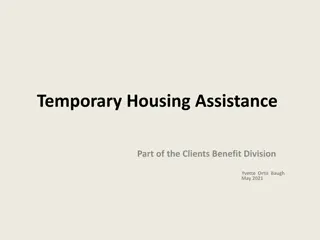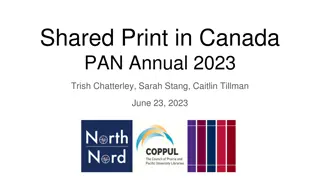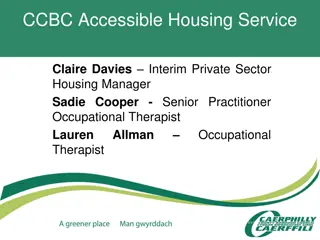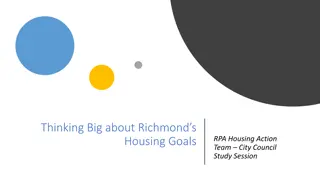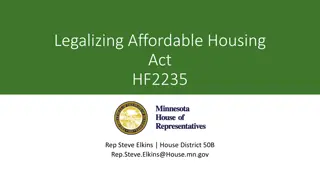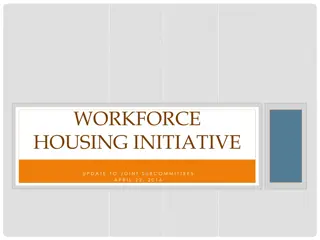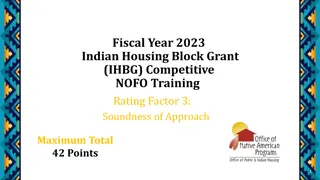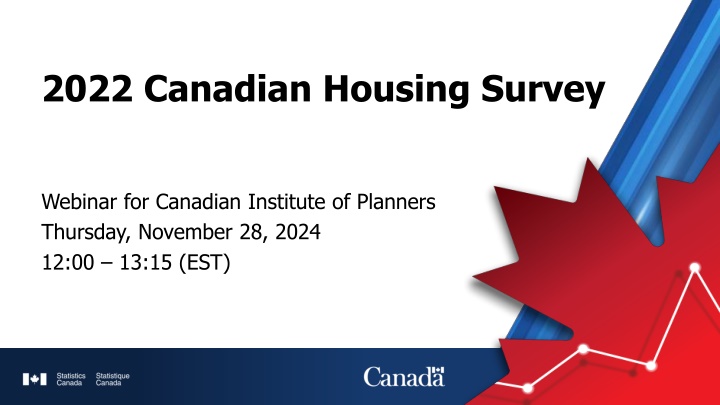
The Canadian Housing Survey (CHS) Findings in 2022
Explore key insights from the 2022 Canadian Housing Survey, focusing on housing affordability, core housing needs, and outcomes for various demographic groups. Discover how the CHS data can inform housing policies for a better future.
Download Presentation

Please find below an Image/Link to download the presentation.
The content on the website is provided AS IS for your information and personal use only. It may not be sold, licensed, or shared on other websites without obtaining consent from the author. If you encounter any issues during the download, it is possible that the publisher has removed the file from their server.
You are allowed to download the files provided on this website for personal or commercial use, subject to the condition that they are used lawfully. All files are the property of their respective owners.
The content on the website is provided AS IS for your information and personal use only. It may not be sold, licensed, or shared on other websites without obtaining consent from the author.
E N D
Presentation Transcript
2022 Canadian Housing Survey Webinar for Canadian Institute of Planners Thursday, November 28, 2024 12:00 13:15 (EST)
What is the Canadian Housing Survey (CHS)? The CHS is a biennial survey administered in partnership with CMHCthat will run for 10 years that started in 2018 It collects information from Canadian households on their homes, communities, housing needs and housing experiences It provides detailed and precise statistics on households in Social and Affordable Housing It is part of the National Housing Strategy s commitment to new, more and better housing information to support better housing outcomes for all Canadians Housing information is KEY to overcoming housing challenges
Overview of CHS concepts Geographies of interest: Provinces and 16 largest CMA/CAs Key housing indicators: Core housing need Dwelling condition Housing affordability Housing suitability Dwelling and neighbourhood satisfaction Experience with forced moves and homelessness Reasons for moving Tenure First-time homebuyers Social and affordable housing Waitlist for social and affordable housing NHS priority population groups: 2SLGBTQ+ people Indigenous people People experiencing homelessness Racialized people Recent immigrants Seniors Women and children Veterans Young adults
What products were recently released? The first results for reference year 2022 from the third cycle of the CHS Housing affordability in Canada, 2022 article in The Daily Updates to 10 data tables on Statistics Canada s data page Microdata file for the 2022 cycle is available through the Research Data Centres New Insights into Housing Needs and Conditions article in CMHC s Housing Observer New data tables on CMHC s Canadian Housing Survey page Future articles and analysis to come in 2024 and 2025
The share of households spending 30% or more of their income on shelter costs returns to pre-pandemic levels Share of households that lived in unaffordable housing The share of households living in unaffordable housing defined as spending 30% or more of their income on shelter costs was 22.0% in 2022, virtually the same as it was in 2018 (21.5%), before the COVID-19 pandemic 33.0 32.9 30.3 22.0 21.5 19.5 16.2 16.1 Households living in social and affordable housing were less likely to be living in unaffordable housing in 2022 (25.4%), compared with 2018 (29.4%) 14.3 All households Owner-occupied Renter 2018 2021 2022 Source(s): Canadian Housing Survey, 2018, 2021 and 2022.
Growing dissatisfaction with housing affordability From 2018 to 2022, shelter costs increased nationally by 20.6%. Against this backdrop, a larger share of Canadians was dissatisfied with the affordability of their housing in 2022 (14.5%) compared to 2018 (11.1%) Share of households dissatisfied with housing affordability 20.8 17.7 17.6 14.5 Two groups were particularly dissatisfied with affordability of their housing: new renters (34.3%) facing low rental vacancies, and first- time homebuyers (21.3%) higher housing prices housing and fluctuating interest rates 11.5 11.2 11.1 8.6 8.2 All households Owner-occupied Renter 2018 2021 2022 Source(s): Canadian Housing Survey, 2018, 2021 and 2022.
Housing is part of larger affordability challenges Share of households reporting having difficulty making ends meet More households found it difficult to make ends meet in 2022 than was the case in 2018 39.4 30.9 30.5 28.8 This phenomenon reflects the historic price increases for essential items experienced by households in 2022 putting pressure on their household budget 26.4 21.9 20.4 18.0 16.4 All households Owner-occupied Renter 2018 2021 2022 Source(s): Canadian Housing Survey, 2018, 2021 and 2022.
Waiting for social and affordable housing can take years for some households In 2022, approximately 245,900 households reported being on a waitlist for subsidized housing, close to two-thirds of whom (153,800) have been waiting for two years or longer Selected outcomes for households living in social and affordable housing 64.5 55.5 44.9 41.7 The long wait may reflect allocation and access priority for subsidized housing units among seniors, families, individuals, and people with disabilities 32.0 30.7 Households waiting for subsidized housing were more likely to be in unaffordable housing (41.7% in 2022) compared with renters and owners, and close to two-thirds (64.5% in 2022) found it difficult to make ends meet 2018 2022 Share of households reporting having difficultly making ends meet Share of households living in unaffordable housing Source(s): Canadian Housing Survey, 2018 and 2022.
New renters face tighter rental market Share of new renter households dissatisfied with housing affordability In 2022, new renters who had moved into their dwelling during the prior two years paid an average of $1,590 in monthly rent, which is 27.0% more than existing tenant households that did not move during that time 35.9 34.3 24.0 23.0 11.9 10.4 New renters (34.3%) were more likely to be dissatisfied with the affordability of their housing compared with all renters (20.8%) New renter households New renters living in social and affordable housing New renters living in market rental housing 2018 2022 Source(s): Canadian Housing Survey, 2018, and 2022.
First-time homebuyers are taking on larger mortgages and are more dissatisfied with housing affordability First-time homebuyer income, outstanding mortgage About 1.3 million households, or 8.6% of all households, bought their first home from 2018 to 2022. The share of households that bought their first home from 2014 to 2018 (8.7%) was virtually the same $280,000 $249,350 The perceived affordability of homeownership changed between cohorts. A larger share of first-time homebuyer households (21.3% in 2022) were dissatisfied with housing affordability, 7.9 percentage points higher than their counterparts in 2018 (13.4%) $114,950 $109,350 The median outstanding mortgage amount increased by 12.3% from $249,350 in 2018 to $280,000 in 2022. Meanwhile, median income of first-time homebuyer households increased by 5.1% over this period 2018 2022 Median outstanding mortgage Median household income Source(s): Canadian Housing Survey, 2018, and 2022.
Core housing need rates relatively stable in 2022 Share of households in core housing need Core housing need results when housing is unaffordable, unsuitable and/or inadequate and households cannot afford alternative suitable and adequate housing in their community 31.9 30.8 26.5 22.5 22.1 21.0 20.9 19.7 18.7 The share of households in core housing need was 11.6% in 2022. This was comparable to 2018, where 11.3% of all households were in core housing need 11.6 11.3 9.8 6.1 6.1 5.1 Renters continue to face greater challenges compared to homeowners. In 2022, 22.1% of renters were in core housing need, compared to 6.1% of homeowners All households Renters Renters in social and affordable housing Renters in market rental housing Homeowners 2018 2021 2022 Source(s): Canadian Housing Survey, 2018, 2021 and 2022.
Affordability issues main reason for households in core housing need Share of households in core housing need by standard(s) not met, 2022 In 2022: 88.4% of households were in core housing need where unaffordability is a factor 16.8% of households were in core housing need where inadequate housing was a factor 9.7% of households were in core housing need where unsuitable housing was a factor Affordability only 4% 1% 4% Affordability and adequacy 7% Adequacy only 1% 8% Affordability and suitability Housing is considered unaffordable when 30% or more of before-tax household income goes towards shelter costs Housing is considered inadequate when it needs major repairs Housing is considered unsuitable when there aren t enough rooms for the size and composition of households Suitability only 75% Suitability and adequacy Affordability, adequacy and suitability Source: Canadian Housing Survey, 2022.
Racialized households are more likely to be in core housing need Share of households in core housing need by racialized identity of reference person, 2022 In 2022, 14.1% of racialized households were in core housing need, compared to 11.6% of all households All households 11.6 Racialized households 14.1 South Asian 12.8 Chinese 14.6 Black 18.3 The rate of core housing need varies by identity Filipino 6.3 Latin American 8.4 Arab 13.2 Southeast Asian 15.4 West Asian 27.7 Korean 26.9 Multiple racialized groups 19.1 Source: Canadian Housing Survey, 2022.
Indigenous households were more likely to be in core housing need Share of households in core housing need by Indigenous status of reference person 17.9 Households that self-identified as Indigenous in the survey were more likely to be in core housing need compared to all households 16.2 15.1 11.6 11.3 11.3 11.1 9.8 9.6 In 2022, 17.9% of Indigenous households were in core housing need, compared to 11.6% of all households All households Indigenous identity Non-Indigenous identity 2018 2021 2022 Source(s): Canadian Housing Survey, 2018, 2021 and 2022.
Highest rates of core housing need are found in British Columbia and Ontario Share of households in core housing need 11.3 Canada (provinces only) 9.8 11.6 In 2022, British Columbia and Ontario had the highest rates of households in core housing need, at 16.0% and 14.5% 9.4 Newfoundland and Labrador 7.4 8.9 6.5 Prince Edward Island 7.2 8.9 11.0 Nova Scotia 9.9 12.9 7.3 New Brunswick 5.9 Qu bec had the lowest rate of households in core housing need across the provinces, at 5.5% 9.2 7.2 Qu bec 6.0 5.5 13.4 Ontario 11.9 14.5 10.9 Manitoba 10.3 Between 2018 and 2022, core housing need rates increased in most provinces except PEI, Qu bec and Saskatchewan 12.0 11.7 Saskatchewan 10.3 9.5 10.2 Alberta 9.0 11.3 14.8 British Columbia 12.5 16.0 2018 2021 2022 Source(s): Canadian Housing Survey, 2018, 2021 and 2022.
Households experiencing significant financial hardship due to housing costs is on the rise Share of households reporting significant financial difficulty because of increased rent or mortgage payments in the last 12 months In 2022, most Canadians reported that their households haven t experienced significant financial difficulty over the past twelve months (77.2%) 2.89.4 6.1 However, the percentage of Canadians reporting they often or sometimes experience financial difficulty because of increased rent or mortgage payments nearly double from 2018 to 2022. It increased from 12.2% to 22.6% of all households between 2018 and 2022 16.5 2018 2022 77.2 87.7 Yes, often Yes, sometimes No Source: Canadian Housing Survey, 2018 and 2022.
Examples of CHS data tables Core housing need, by tenure including first-time homebuyer and social and affordable housing status (Table 46-10-0085-01) Dimensions of core housing need, by tenure including first-time homebuyer and social and affordable housing status (Table 46-10-0086-01) Households living with housing problems, by selected housing-vulnerable populations and core housing need including adequacy, affordability and suitability standards (Table 46-10-0067-01) Persons living with housing problems, by selected housing-vulnerable populations and core housing need including adequacy, affordability and suitability standards (Table 46- 10-0068-01) and more!
Cycle 4 in collection since October 2024 Reference year 2024 CHS is in collection October 28, 2024 to March 31, 2025 Returning and enhanced topics on housing affordability, core housing need, experience of homelessness, forced moves, social and affordable housing and subjective assessments of housing experiences and conditions New content on: housing discrimination and housing aspirations elements of Adequate Housing, as defined by the United Nations sociodemographic characteristics to identify population groups most in need including those with long-term conditions and disabilities
Stay connected! StatsCAN app Website Eh Sayers podcast Surveys and statistical programs StatsCAN Plus Data service centres The Daily My StatCan Facebook logo Instagram logo LinkedIn Youtube logo Reddit logo X logo Stats App logo Podcast logo Questions? Contact us: infostats@statcan.gc.ca
Stay connected with CMHC! Canadian Housing Survey Observer Article Data tables Questions? Contact us: CMHC Senior Specialist - Stephanie Shewchuk sshewchu@cmhc-schl.gc.ca
Statistics Canada Your National Statistical Agency Delivering insight through data for a better Canada





